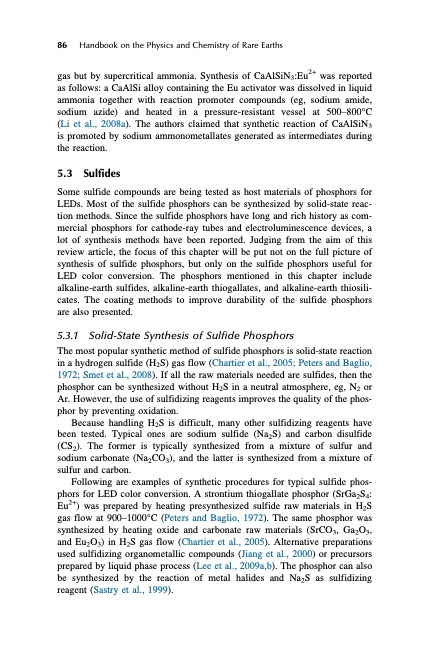
PDF Publication Title:
Text from PDF Page: 122
86 Handbook on the Physics and Chemistry of Rare Earths gas but by supercritical ammonia. Synthesis of CaAlSiN3:Eu2+ was reported as follows: a CaAlSi alloy containing the Eu activator was dissolved in liquid ammonia together with reaction promoter compounds (eg, sodium amide, sodium azide) and heated in a pressure-resistant vessel at 500–800°C (Li et al., 2008a). The authors claimed that synthetic reaction of CaAlSiN3 is promoted by sodium ammonometallates generated as intermediates during the reaction. 5.3 Sulfides Some sulfide compounds are being tested as host materials of phosphors for LEDs. Most of the sulfide phosphors can be synthesized by solid-state reac- tion methods. Since the sulfide phosphors have long and rich history as com- mercial phosphors for cathode-ray tubes and electroluminescence devices, a lot of synthesis methods have been reported. Judging from the aim of this review article, the focus of this chapter will be put not on the full picture of synthesis of sulfide phosphors, but only on the sulfide phosphors useful for LED color conversion. The phosphors mentioned in this chapter include alkaline-earth sulfides, alkaline-earth thiogallates, and alkaline-earth thiosili- cates. The coating methods to improve durability of the sulfide phosphors are also presented. 5.3.1 Solid-State Synthesis of Sulfide Phosphors The most popular synthetic method of sulfide phosphors is solid-state reaction in a hydrogen sulfide (H2S) gas flow (Chartier et al., 2005; Peters and Baglio, 1972; Smet et al., 2008). If all the raw materials needed are sulfides, then the phosphor can be synthesized without H2S in a neutral atmosphere, eg, N2 or Ar. However, the use of sulfidizing reagents improves the quality of the phos- phor by preventing oxidation. Because handling H2S is difficult, many other sulfidizing reagents have been tested. Typical ones are sodium sulfide (Na2S) and carbon disulfide (CS2). The former is typically synthesized from a mixture of sulfur and sodium carbonate (Na2CO3), and the latter is synthesized from a mixture of sulfur and carbon. Following are examples of synthetic procedures for typical sulfide phos- phors for LED color conversion. A strontium thiogallate phosphor (SrGa2S4: Eu2+) was prepared by heating presynthesized sulfide raw materials in H2S gas flow at 900–1000°C (Peters and Baglio, 1972). The same phosphor was synthesized by heating oxide and carbonate raw materials (SrCO3, Ga2O3, and Eu2O3) in H2S gas flow (Chartier et al., 2005). Alternative preparations used sulfidizing organometallic compounds (Jiang et al., 2000) or precursors prepared by liquid phase process (Lee et al., 2009a,b). The phosphor can also be synthesized by the reaction of metal halides and Na2S as sulfidizing reagent (Sastry et al., 1999).PDF Image | HANDBOOK ON THE PHYSICS AND CHEMISTRY OF RARE EARTHS

PDF Search Title:
HANDBOOK ON THE PHYSICS AND CHEMISTRY OF RARE EARTHSOriginal File Name Searched:
Chemistry-Rare-Earths-49.pdfDIY PDF Search: Google It | Yahoo | Bing
Sulfur Deposition on Carbon Nanofibers using Supercritical CO2 Sulfur Deposition on Carbon Nanofibers using Supercritical CO2. Gamma sulfur also known as mother of pearl sulfur and nacreous sulfur... More Info
CO2 Organic Rankine Cycle Experimenter Platform The supercritical CO2 phase change system is both a heat pump and organic rankine cycle which can be used for those purposes and as a supercritical extractor for advanced subcritical and supercritical extraction technology. Uses include producing nanoparticles, precious metal CO2 extraction, lithium battery recycling, and other applications... More Info
| CONTACT TEL: 608-238-6001 Email: greg@infinityturbine.com | RSS | AMP |